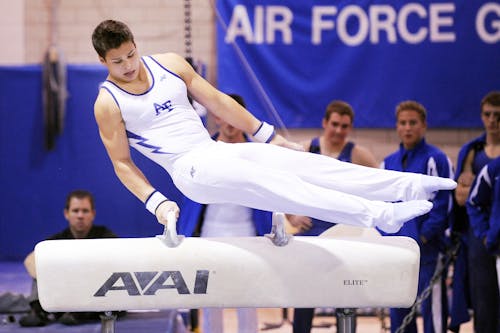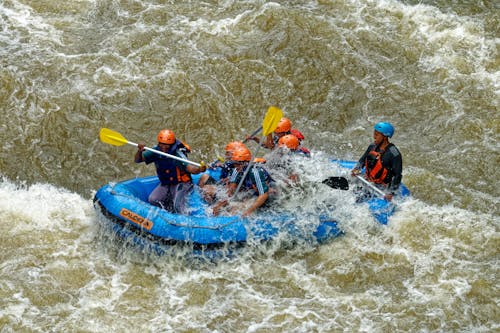 |
| Gymnastics List of sports |
Daniele Hypólito on the equalization bar at the 2007 Pan American Games
Vaulting is a game that incorporates practices requiring balance, quality, adaptability, readiness, coordination and continuance. The developments engaged with acrobatic add to the improvement of the arms, legs, shoulders, back, chest and stomach muscles gatherings. Readiness, exactness, brave, fearlessness and self-control are mental qualities that can likewise be created through gymnastics.Gymnastics advanced from activities utilized by the antiquated Greeks that included abilities for mounting and getting off a steed, and from bazaar execution aptitudes.
Most types of focused tumbling occasions are administered by the Fédération Internationale de Gymnastique (FIG). Every nation has its own national administering body (BIW) partnered to FIG. Focused masterful acrobatic is the best known about the gymnastic occasions. It normally includes the ladies' occasions of vault, uneven bars, balance shaft and floor practice just as the men's occasions of floor work out, beat horse, still rings, vault, parallel bars and level bar.
Other FIG disciplines incorporate musical vaulting, trampolining and tumbling, aerobatic acrobatic and vigorous tumbling. Orders not as of now perceived by FIG incorporate wheel acrobatic, tasteful gathering aerobatic, men's musical tumbling, TeamGym and mallakhamba. Members can incorporate youngsters as youthful as 20 months old doing kindergym and kids' aerobatic, recreational gymnasts of ages 3 and up, aggressive gymnasts at different dimensions of ability, and world-class competitors.
"Gymnastics" gets from the basic Greek descriptive word γυμνός (gymnos), by method for the related action word γυμνάζω (gymnazo), whose significance is to "train stripped", "train in gymnastic exercise", for the most part "to prepare, to exercise".[3] The action word had this importance, since competitors in old occasions practiced and contended without attire. It came into utilization during the 1570s, from Latin gymnasticus, from Greek gymnastikos "partial to or gifted in substantial exercise," from gymnazein "to exercise or prepare" (see gym).
History
Aerobatic created in old Greece, in Sparta and Athens, and was utilized as technique to get ready men for fighting. In Sparta, among the exercises brought into the preparation program was the Agoge or display aerobatic made up of gymnastic components as the Pyrrhic-a move in a military style-performed for state dignitaries in the last year of an understudy's preparation. The moves were performed stripped aside from the apparatuses of war. Athens consolidated this progressively physical preparing with instruction of the psyche. At the Palestra, a physical instruction preparing focus, the control of teaching the body and teaching the brain were consolidated taking into consideration a type of vaulting that was progressively tasteful and individual and which abandoned the shape that concentrated on strictness, discipline, the accentuation on vanquishing records, and spotlight on strength
Wear Francisco Amorós y Ondeano, was conceived on February 19, 1770 in Valencia and kicked the bucket on August 8, 1848 in Paris. He was a Spanish colonel, and the principal individual to present educative gymnastic in France. Jahn advanced the utilization of parallel bars, rings and high bars in global competition.
Mid twentieth century tumbling in Stockholm, Sweden
The Federation of International Gymnastics (FIG) was established in Liege in 1881 By the finish of the nineteenth century, men's tumbling rivalry was well sufficiently known to be incorporated into the primary "current" Olympic Games in 1896. From that point on until the mid 1950s, both national and worldwide rivalries included a changing assortment of activities assembled under the rubric, aerobatic, that included for instance, synchronized group floor workout, rope climbing, high bouncing, running, and flat stepping stool. Amid the 1920s, ladies sorted out and took an interest in acrobatic occasions. The principal ladies' Olympic challenge was crude, just including synchronized exercises and olympic style sports. These diversions were held in 1928, in Amsterdam.
By 1954, Olympic Games contraption and occasions for the two people had been institutionalized in present day configuration, and uniform reviewing structures (counting a point framework from 1 to 15) had been settled upon. As of now, Soviet gymnasts amazed the world with very taught and troublesome exhibitions, setting a point of reference that proceeds. TV has announced and start a cutting edge period of vaulting. The two people's tumbling currently draw in significant universal intrigue, and superb gymnasts can be found on each mainland.
In 2006, another focuses framework for Artistic vaulting was put into play. With an A Score (or D score) being the trouble score, which starting at 2009 depends on the best 8 high scoring components in an everyday practice (barring Vault). The B Score (or E Score), is the score for execution, and is given for how well the abilities are performed.
FIG-perceived orders
See additionally: List of vaulting rivalries and Major accomplishments in aerobatic by country
The accompanying orders are administered by FIG.
Creative acrobatic
Primary article: Artistic acrobatic
Creative Gymnastics is normally partitioned into Men's and Women's Gymnastics. Men contend on six occasions: Floor Exercise, Pommel Horse, Still Rings, Vault, Parallel Bars, and Horizontal Bar, while ladies contend on four: Vault, Uneven Bars, Balance Beam, and Floor Exercise. In a few nations, ladies at one time contended on the rings, high bar, and parallel bars (for instance, during the 1950s in the USSR).
In 2006, FIG presented another focuses framework for Artistic acrobatic in which scores are never again restricted to 10 points. The framework is utilized in the US for world class level competition.[7] Unlike the old code of focuses, there are two separate scores, an execution score and a trouble score. In the past framework, the "execution score" was the main score. It was and still is out of 10.00, aside from short activities. Amid the tumbler's execution, the judges deduct this score as it were. A fall, on or off the occasion, is a 1.00 finding, in tip top dimension tumbling. The presentation of the trouble score is a huge change. The acrobat's trouble score depends on what components they perform and is liable to change on the off chance that they don't perform or finish every one of the aptitudes, or they don't interface an ability intended to be associated with another. Association rewards are the place deviation happens most normal between the expected and genuine trouble scores, as it tends to be hard to interface different flight components. It is difficult to associate aptitudes if the principal expertise isn't performed effectively. The new code of focuses enables the gymnasts to increase higher scores dependent on the trouble of the aptitudes they execute just as their execution. There is no most extreme score for trouble, as it can continue expanding as the trouble of the aptitudes increment.
Masterful occasions for ladies
Piked Tsukahara vault.
Vault
Fundamental article: Vault
In the vaulting occasions, gymnasts dash down a 25 meters (82 ft) runway, hop onto a springboard (or play out a roundoff or handspring passage onto a springboard), arrive quickly transformed on the hands on the vaulting steed or vaulting table (pre-flight section), at that point drive themselves forward or in reverse off that stage to a two-footed landing (post-flight portion). Each tumbler begins at an alternate point on the vault runway relying upon their stature and quality. The post-flight fragment may incorporate at least one different saltos, somersaults, or bending developments. A round-off passage vault, called a Yurchenko, is the most widely recognized vault in the more elevated amounts in aerobatic. When playing out a Yurchenko, gymnasts "round off" so their hands are on the runway while their feet arrive on the springboard. From the roundoff position, the acrobat ventures in reverse and executes a back handspring with the goal that the hands arrive on the vaulting table. The athlete at that point close off the vaulting stage into different winding as well as somersaulting blends. The post-flight section conveys the athlete to her feet. In the lower dimensions of aerobatic, the gymnasts don't play out this move. These gymnasts will hop onto the springboard with the two feet in the meantime and either complete a front handspring onto the vault or a roundoff onto the vault.
In 2001, the customary vaulting steed was supplanted with another device, here there known as a tongue, steed or vaulting table. The new mechanical assembly is progressively steady, more extensive, and longer than the more seasoned vaulting steed, around 1 m long and 1 m in width, giving gymnasts a bigger blocking surface. This mechanical assembly is along these lines considered more secure than the vaulting steed utilized before. With the expansion of this new, more secure vaulting table, gymnasts are attempti







